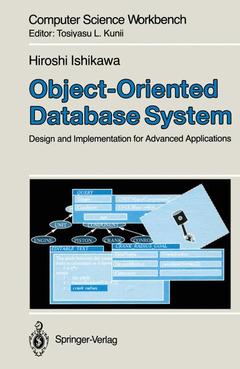Object-Oriented Database System, Softcover reprint of the original 1st ed. 1993 Design and Implementation for Advanced Applications Computer Science Workbench Series
Langue : Anglais
Auteur : Ishikawa Hiroshi

Computer Science Workbench is a monograph series which will provide you with an in depth working knowledge of current developments in computer technology. Every volume in this series will deal with a topic of importance in computer science and elaborate on how you yourself can build systems related to the main theme. You will be able to develop a variety of systems, including computer software tools, computer graphics, computer animation, database management systems, and computer-aided design and manufacturing systems. Computer Science Workbench represents an important new contribution in the field of practical computer technology. Tosiyasu L. Kunii Preface The goal of this book is to give concrete answers to questions such as what object oriented databases are, why they are needed, how they are implemented, and how they are applied, by describing a research prototype object-oriented database system called Jasmine. That is, this book is aimed at creating a consistent view to object-oriented databases. The contents of this book are directly based on the results of the Jasmine project conducted at Fujitsu Laboratories, Ltd. The book is a polished version of my doctoral dissertation, which includes research papers which I have authored and published.
1. Introduction.- 1.1 Motivation.- 1.2 Overview.- 2. Data Model.- 2.1 Object Semantics.- 2.2 Classification and Generalization.- 2.3 System-Defined Classes.- 2.4 More Formal Semantics.- 3. Database Programming Language.- 3.1 Set-Oriented Access.- 3.1.1 Object expressions.- 3.1.2 Queries.- 3.1.3 Incomplete knowledge access.- 3.1.4 Set-oriented operation.- 3.1.5 Aggregate functions and set functions.- 3.1.6 Procedural attributes in conditions.- 3.1.7 Demons.- 3.2 More Formal Semantics.- 3.2.1 Object operators.- 3.2.2 Query semantics.- 3.3 Singleton Access and Object Variables.- 3.4 Procedural Attribute and Demon Definition.- 3.5 Miscellaneous Operations.- 3.5.1 Class operations.- 3.5.2 Database operations.- 3.5.3 Multimedia operations.- 3.5.4 Persistent objects and temporary objects.- 4. Implementation.- 4.1 System Architecture.- 4.2 Data Management Subsystem.- 4.2.1 Relation organization.- 4.2.2 Predicate and manipulation functions.- 4.2.3 Operators.- 4.2.4 Implementation detail.- 4.3 Object Management Subsystem.- 4.3.1 Storage structures of objects.- 4.3.2 Set-oriented support.- 4.3.2.1 Query graph generation.- 4.3.2.2 Access plan generation.- 4.3.2.3 Object-oriented query optimization.- 4.3.3 Singleton access support and object buffering.- 4.3.4 Support for miscellaneous operations.- 4.3.5 Interpreter.- 4.3.6 Extensibility.- 5. Artificial Intelligence Applications.- 5.1 Introduction.- 5.2 System Overview.- 5.3 World Model Design.- 5.3.1 Domain model.- 5.3.1.1 Classification and aggregation.- 5.3.1.2 Generalization.- 5.3.1.3 Derivation.- 5.3.1.4 Integration.- 5.3.2 Linguistic model.- 5.3.3 Mapping.- 5.4 Semantic Interpretation.- 5.4.1 Issues in parsing.- 5.4.2 Our approach.- 5.4.2.1 Meaning representation.- 5.4.2.2 Principles for using the WM.- 5.4.2.3 Rules.- 5.4.2.4 Control of rules.- 5.4.2.5 How the rules work.- 5.5 Query Translation.- 5.5.1 WM query language.- 5.5.2 Our approach to translation.- 5.5.3 Translation rules.- 5.5.3.1 Target ruleset.- 5.5.3.2 Groupby ruleset.- 5.5.3.3 Having ruleset.- 5.5.3.4 Qualification ruleset.- 5.5.3.5 Translation example.- 5.6 Conclusion.- 5.6.1 Related work.- 5.6.2 Summary.- 6. Hypermedia Applications.- 6.1 Introduction.- 6.2 Current Hypermedia Systems.- 6.2.1 Common characteristics.- 6.2.2 Issues.- 6.3 Data Model.- 6.3.1 Object semantics.- 6.3.2 Classification and generalization.- 6.4 Database Programming Language.- 6.4.1 Object expressions.- 6.4.2 Queries.- 6.4.3 Incomplete knowledge access.- 6.4.4 Set-oriented operation.- 6.4.5 Procedural attributes in conditions.- 6.4.6 Demons.- 6.4.7 Class operations.- 6.5 Application of Jasmine.- 6.5.1 Hypermedia engine.- 6.5.2 Hypermedia model.- 6.5.3 Solutions.- 6.6 Conclusion.- 6.6.1 Related work.- 6.6.2 Experiment.- 7. Engineering Applications.- 7.1 Introduction.- 7.2 Object-Oriented Database.- 7.2.1 Functionality.- 7.2.2 Implementation.- 7.3 Issues for Engineering Tasks.- 7.4 Design Data Management.- 7.5 Intelligent CAD Support.- 7.6 Engineering Information Management.- 7.7 Conclusion.- 7.7.1 Related work.- 7.7.2 Summary.- 8. Conclusion.- 8.1 Related Work.- 8.2 Summary.- A Query Expression Syntax.
Date de parution : 01-2012
Ouvrage de 164 p.
15.5x23.5 cm
Disponible chez l'éditeur (délai d'approvisionnement : 15 jours).
Prix indicatif 52,74 €
Ajouter au panierThèmes d’Object-Oriented Database System :
© 2024 LAVOISIER S.A.S.



